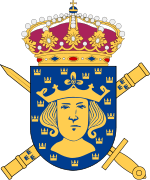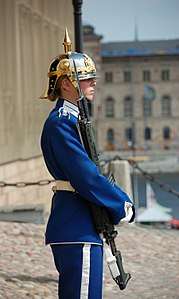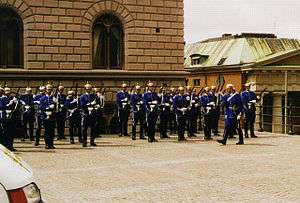Royal Guards (Sweden)
| Royal Guards | |
|---|---|
| Högvakten | |
 Coat of arms of Royal Guards and the Commandant General in Stockholm. | |
| Active | 1523–present |
| Country |
|
| Allegiance | King Carl XVI Gustaf of Sweden |
| Branch |
|
| Type |
|
| Role | Honor guard |
| Garrison/HQ |
Stockholm Palace Drottningholm Palace |
| Motto(s) | |
The Royal Guards (Swedish: Högvakten), the Main Guard at the Stockholm Palace is carried out by units of the Swedish Armed Forces. It is the King of Sweden's guard of honour and is responsible for the protection of the Swedish Royal Family. The Royal Guard is normally divided in two parts, the main guard stationed at the Stockholm Palace, and a smaller detachment at Drottningholm Palace. The Royal Guard traces its history back to the early 16th Century, and the unit has continuously guarded the Royal Palace in Stockholm since 1523.
The duty of forming a "Royal Guard" is bestowed upon all serving regiments and occasionally on other detachments of the National Forces (like the Home Guard). However, these detachments only serve for about 5–7 days in each rotation, so the main part of the year, the Royal Guard duty is being performed by the Life Guards, with traditions and roots from the old Household Brigade and Svea Life Guards and Life Guard Dragoons. The Lifeguards consist of four battalions, one light infantry, two security and one guard battalion.
Between April and August, the mounted squadrons in light blue uniforms and silver helmets and the companies in dark blue uniforms with black helmets of Life Guards can be seen in Stockholm and around the Royal Palace. Accompanied by the mounted band, they depart from the Cavalry barracks in Gärdet and arrive at the Palace around noon (1 pm on Sundays and public holidays) for the changing of the guards ceremony. These events attracts large numbers of tourists each summer.[1][2]
In the regular guard mounts, the regular royal guard contingent is composed of the personnel from the King's Guards Battalion, Life Guards.
Gallery
 Royal Swedish Guard
Royal Swedish Guard Relieved guard after the changing of the guards ceremony at the Royal Palace. The clear blue uniform is used solely by the soldiers of the Cavalry Battalion
Relieved guard after the changing of the guards ceremony at the Royal Palace. The clear blue uniform is used solely by the soldiers of the Cavalry Battalion Mounted Royal Guards in front of the palace
Mounted Royal Guards in front of the palace
External Links
| Wikimedia Commons has media related to Royal Guards (Sweden). |